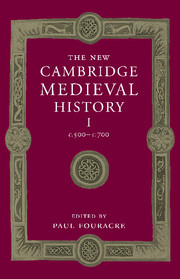Book contents
- Frontmatter
- Introduction: the history of Europe 500–700
- 1 The later Roman Empire
- 2 The Barbarian invasions
- 3 The sources and their interpretation
- PART I THE SIXTH CENTURY
- PART II THE SEVENTH CENTURY
- PART III THEMES AND PROBLEMS
- 20 The Jews in Europe 500–1050
- 21 Kings and kingship
- 22 The Mediterranean economy
- 23 The Northern Seas (fifth to eighth centuries)
- 24 Money and coinage
- 25 Church structure and organisation
- 26 Christianisation and the dissemination of Christian teaching
- 27 Education and learning
- 28A Art and architecture of western Europe
- 28B Art and architecture: the East
- List of Primary sources
- Bibliography of secondary works arranged by chapter
- Index
- Frontispiece"
- Plate section"
- Map 3 Gaul/Francia in the sixth and seventh centuries"
- References
20 - The Jews in Europe 500–1050
from PART III - THEMES AND PROBLEMS
Published online by Cambridge University Press: 28 March 2008
- Frontmatter
- Introduction: the history of Europe 500–700
- 1 The later Roman Empire
- 2 The Barbarian invasions
- 3 The sources and their interpretation
- PART I THE SIXTH CENTURY
- PART II THE SEVENTH CENTURY
- PART III THEMES AND PROBLEMS
- 20 The Jews in Europe 500–1050
- 21 Kings and kingship
- 22 The Mediterranean economy
- 23 The Northern Seas (fifth to eighth centuries)
- 24 Money and coinage
- 25 Church structure and organisation
- 26 Christianisation and the dissemination of Christian teaching
- 27 Education and learning
- 28A Art and architecture of western Europe
- 28B Art and architecture: the East
- List of Primary sources
- Bibliography of secondary works arranged by chapter
- Index
- Frontispiece"
- Plate section"
- Map 3 Gaul/Francia in the sixth and seventh centuries"
- References
Summary
introduction and sources
The early Middle Ages saw the establishment of Jewish life in major parts of Europe. In this period the Mediterranean–Hellenistic Jewry of antiquity separated and developed into Byzantine–southern Italian, Roman, Catalan-southern French and Arabic–Sicilian branches. During the later part of the period Ashkenazic (north-western and northern European) and Sephardic (Iberian) Jewry came into being as distinctive entities very different from earlier patterns. There were (probably) also some Jews in eastern Europe, of which almost nothing is known but a vague association with Byzantium. Jews held to a common creed yet differed in language, religious custom and ritual, social organisation, occupations and legal standing, a fact that militates against easy historical inferences from an ostensibly fixed character. At different times and to differing degrees, they were under the influence of the centres of gravity – demographic, religious, intellectual – of Jewish life in the Middle East, especially Palestine and Babylonia. Compared to these, throughout most of the period under consideration, European Jews in numbers or intellectual creativity were yet barely remarkable. None the less, modern historians have usually accorded them a significance out of proportion. In this they faithfully followed medieval churchmen, to whom Jews presented a challenge far in excess of their actual presence and impact.
It is thus not by accident that our view is further hampered by an ambiguous and severely unbalanced source tradition. For the greater part of Europe there exists a considerable body of texts of ecclesiastical provenance – the Lives and miracles of saints, chronicles and histories, epistles, form letters, the decisions of synods, canonical collections, theological treatises – complemented by lawcodes, imperial or royal legislation and charters.
Keywords
- Type
- Chapter
- Information
- The New Cambridge Medieval History , pp. 545 - 570Publisher: Cambridge University PressPrint publication year: 2005
References
- 2
- Cited by



